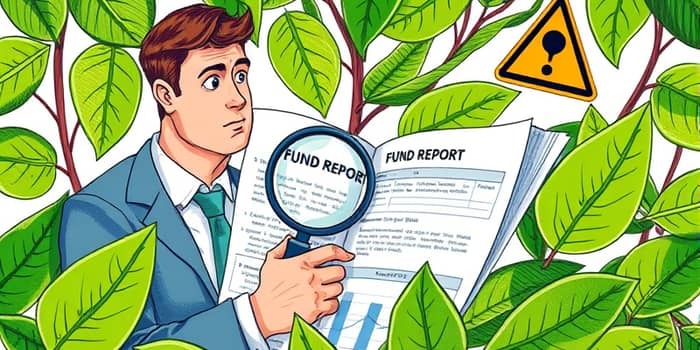
Sustainable investing has surged in popularity as more individuals seek to align their portfolios with environmental and social values. Yet, not all that glitters is green. Misleading sustainability claims related to products can lure investors into funds that fail to deliver genuine impact.
By understanding how greenwashing operates and demanding clarity, investors can protect their capital and principles. This article outlines the dynamics of greenwashing and offers practical guidance on portfolio holdings and voting records scrutiny.
Greenwashing occurs when a fund’s marketing implies robust environmental credentials, but its actual investments tell a different story. It undermines trust and can misdirect capital away from truly sustainable enterprises.
The European Securities and Markets Authority (ESMA) defines greenwashing as misleading sustainability claims related to products or services, intentional or inadvertent. When funds highlight their green attributes without transparent backing, they erode the integrity of the sustainable finance marketplace.
For investors, distinguishing genuine impact from superficial claims is vital to avoid financial, ethical, and reputational risks and to ensure their money truly drives positive change.
Greenwashing can manifest in various guises. Recognizing these patterns empowers investors to ask critical questions and demand evidence.
These tactics range from subtle omissions to overt overstatement. A fund might tout its low-carbon strategy while still holding significant stakes in fossil fuel companies, or it may claim commitments without reporting transparent and verifiable ESG methodologies.
The rush to capture the growing ESG investment market drives many fund managers to emphasize sustainability, even when meaningful action lags behind the rhetoric. Competitive pressures and consumer demand make environmental branding a powerful marketing tool.
Moreover, implementing comprehensive sustainability practices across complex global portfolios is challenging. It can be easier to craft persuasive narratives than to overhaul investment processes, leading to a gap between claims and reality.
Investors should maintain ongoing skepticism and due diligence when evaluating funds. Look for the following warning signs:
True accountability in sustainable investing rests on clear, accessible reporting. When funds disclose underlying investments, methodological frameworks, and proxy voting behavior, investors can verify claims independently.
Regulatory bodies across Europe, Australia, and North America are increasingly requiring enhanced ESG disclosures. Standardized labels and reporting guidelines aim to level the playing field and deter greenwashing, bolstering industry integrity and investor confidence.
Proactive measures can shield portfolios from greenwashed products and ensure that investments align with values and objectives.
While there is no single global definition of greenwashing, momentum is building toward comprehensive regulation. In the EU, the Sustainable Finance Disclosure Regulation (SFDR) imposes rigorous disclosure requirements on asset managers. Australia’s regulatory bodies have also pursued legal action against funds making false environmental claims.
As regulatory scrutiny sharpens, market participants will face greater incentives to adopt authentic sustainable practices. Investors who champion transparency and hold managers to high standards will play a pivotal role in shaping a more honest and effective sustainable finance ecosystem.
Greenwashing undermines both investor trust and the goals of the sustainable finance movement. By cultivating ongoing skepticism and due diligence, scrutinizing disclosures, and leveraging regulatory frameworks, investors can distinguish genuine green opportunities from mere marketing ploys.
Empowered with knowledge and the tools to demand transparency, you can direct your capital to funds that not only promise sustainable impact but also deliver it in practice.
References













